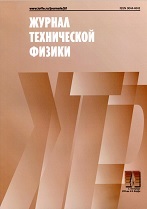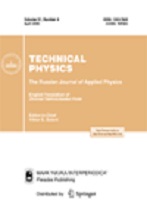|
Electrophysics
Peculiarities of the discharge formation in a plasma accelerator and structure of a jet flowing into vacuum
V. Yu. Goryainova, M. E. Viktorovb, A. V. Vodopyanovb, A. V. Voronina
a Ioffe Institute, St. Petersburg
b Federal Research Center The Institute of Applied Physics of the Russian Academy of Sciences, Nizhny Novgorod
Abstract:
Results of investigation of jet structure created by coaxial plasma accelerator with conical insert in discharge formation region are presented. An irregular structure of the glowing argon and deuterium jet fraction was detected using a fast electron-optical camera. An irregular structure of the glowing argon and deuterium jet fractions was detected using a fast camera. Oscillations of jet radiation intensity with characteristic frequency 0.3–0.9 MHz were detected. The jet of argon plasma consisted of fragments diverging from the axis of motion, the plasma recombined 20 $\mu$s after the start of current. The deuterium plasma jet was like flakes. The intensity of its radiation significantly decreased by 8 $\mu$s. The characteristic frequencies of irregularities of radiation on jet axis for argon were $\sim$0.09 cm$^{-1}$, for deuterium $\sim$0.3 cm$^{-1}$. Studies of discharge behavior in plasma accelerator demonstrate that diffuse discharge was initiated at the bottom of conical insert. After 0.5 $\mu$s discharge exited to the outer edge of insert, counteracted and burned between central and outer electrodes. Discharge exit from accelerator was observed after 3 $\mu$s and was accompanied by glowing of end of central electrode. In the course of measuring the temperature of side surface of the external electrode using infrared camera, the localization of heating was detected near the edge of conical insert and at accelerator outlet. The research results can be used for gas ionization, in the irradiation of materials, as well as for laboratory simulation of the interaction of plasma flows with a magnetic field in space.
Keywords:
coaxial plasma accelerator, fast camera, infrared camera, jet structure, discharge evolution.
Received: 30.04.2020
Revised: 08.07.2020
Accepted: 24.07.2020
Citation:
V. Yu. Goryainov, M. E. Viktorov, A. V. Vodopyanov, A. V. Voronin, “Peculiarities of the discharge formation in a plasma accelerator and structure of a jet flowing into vacuum”, Zhurnal Tekhnicheskoi Fiziki, 91:2 (2021), 335–341; Tech. Phys., 66:2 (2021), 325–332
Linking options:
https://www.mathnet.ru/eng/jtf5088 https://www.mathnet.ru/eng/jtf/v91/i2/p335
|


| Statistics & downloads: |
| Abstract page: | 103 | | Full-text PDF : | 29 |
|





 Contact us:
Contact us: Terms of Use
Terms of Use
 Registration to the website
Registration to the website Logotypes
Logotypes








 Citation in format
Citation in format 